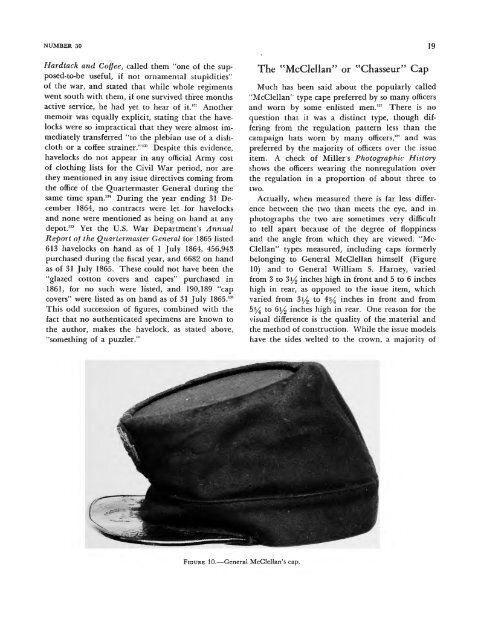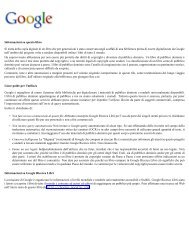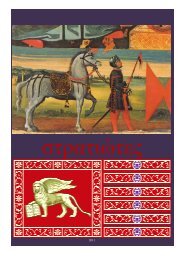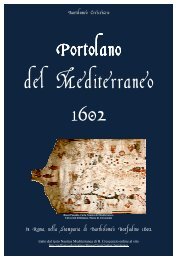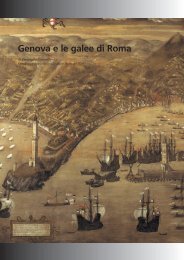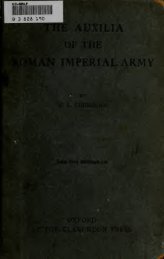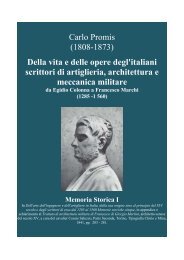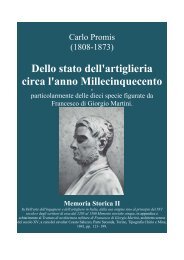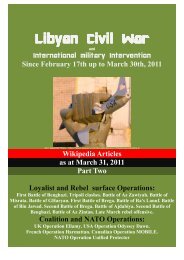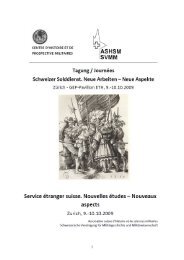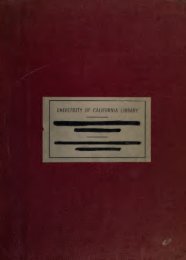18SMITHSONIAN STUDIES IN HISTORY AND TECHNOLOGYadvantageously employed . . in the public service.""'The unit was ordered into the service inAugust."'No official authorization for the issue of a uniformof a special color to this unit has been found.Such an issue at this time was not an exception,however, despite the tremendous pressure on theQuartermaster Department to clothe a rapidlygrowing army, for a number of so-called elite organizationsas the numerous Zouave regiments, theClinton Rifles, and the 4th Regiment of the ExcelsiorBrigade received such."^ In any case, Berdan,who has been described as a highly aggressive individual,""was given a uniform of near regulationcut but of a medium to dark green color, as wellas leather knapsacks of a "Prussian" pattern andleather leggings of "a sample approved" by Berdan,"'and a green forage cap carrying a blackplume."^ The caps were first issued some time priorto 5 November. The maker of the first cap is unknown,but the first group of green uniforms wasmade by Martin Brothers of New York City."" Boththe uniforms and caps were not children of thefirst heat of the war, but like Zouave uniforms,continued to be issued, the green to the sharpshootersas late as 1864.''°One other sealed sample has been examined, althoughnonregulation, and is of considerable interest,that manufactured for Gosline's Zouaves,the 95th Regiment of Infantry, Pennsylvania Volunteers(Figure 9). Of dark blue cloth, it is pipedin red at head band and crown and vertically front,rear and sides. Somewhat lower than the issueitem, it measures 3 inches high in front, 5i/2 incheshigh in rear and is fitted with a flat visor. Affixedto the interior of the crown with a red wax sealwith "Office of Clothing . . . [most probably 'andEquipage'] USA" surrounding an eagle impressedon it, is the contemporary handwritten label"Charles Laing & Co./100 Zouave/Forage Caps/forCol Goslines/Regiment.'Cap Covers and HavelocksOne of the long-standing complaints against boththe 1825 and 1839 forage caps, besides their issueat the rate of but one per five year enlistment, hadbeen the fact that they were pervious to water andwere issued without a water-proof cover.'" Whenthe multipurpose 1851 cap was adopted, however.a cap cover " (to be worn in bad weather) black,of suitable water proof material, with a cape extendingbelow the cap ten inches, coming wellforward, and tying under the chin" was authorized."'When forage caps were first issued to theCompany of Sappers, Miners, and Pontoniers earlyin 1858, cap covers of an unspecified design andmaterial were issued with them."'When a forage cap was adopted for the whole<strong>Army</strong> later that year, however, the question of acap cover was not mentioned. In fact, such was notincluded in official cost of clothing lists until1862."' Schuylkill Arsenal had continued to manufacturethe caps until the great expansion of the<strong>Army</strong> in 1861, and although contracts for themwere let as early as July, it was not until late Octoberthat caps 'with cotton glazed covers andcapes" were purchased."* These were listed in the1862 cost of clothing list at $.18, but no rate ofissue was indicated."" Despite the fact that thesecovers were purchased in relatively large numbersand were available for issue throughout the war,they apparently were seldom worn. Pictures oftheir use are rare, there being few such in the wholeof Miller's Photographic History of the CivilWar.''-'' During the fiscal year ending 30 June1865, no covers were bought or manufactured, withmore than 190,000 remaining on hand on the latterdate."' These cap covers are extremely raretoday and are not represented in the National Collections.For this reason, no illustration is included.The question of havelocks is something of apuzzler. A havelock was a light cloth covering forheadgear, hanging well down over the neck, wornfor protection against the sun, reputedly designedby Sir Henry Havelock, a British general servingin India. It must have been somewhat similarto the 1851 cap cover."" There is no question thatsuch were worn in the early days of the Civil War.Although no photographs showing their use havebeen found by the author in the many volumes ofCivil War photographs checked, the special artist,Alfred R. Waud, who was noted for his accuratedetail, very definitely depicts a scouting party wearingthem in a sketch dated June 1861."" In addition,several lithographs and woodcuts of the Battleof Bull Run in July 1861 show Federal troops inhavelocks."' There are also references in war memoirsthat leave no doubt that they were worn, if toa very limited degree. John D. Billings, in his
NUMBER 30 19Hardtack and Coffee, called them "one of the supposed-to-beuseful, if not ornamental stupidities"of the war, and stated that while whole regimentswent south with them, if one survived three monthsactive service, he had yet to hear of it."' Anothermemoir was equally explicit, stating that the havelockswere so impractical that they were almost immediatelytransferred "to the plebian use of a dishclothor a coffee strainer.""' Despite this evidence,havelocks do not appear in any official <strong>Army</strong> costof clothing lists for the Civil War period, nor arethey mentioned in any issue directives coming fromthe office of the Quartermaster General during thesame time span."' During the year ending 31 December1864, no contracts were let for havelocksand none were mentioned as being on hand at anydepot."' Yet the U.S. War Department's AnnualReport of the Quartermaster General for 1865 listed613 havelocks on hand as of 1 July 1864, 456,943purchased during the fiscal year, and 6682 on handas of 31 July 1865. These could not have been the"glazed cotton covers and capes" purchased in1861, for no such were listed, and 190,189 "capcovers" were listed as on hand as of 31 July 1865.""This odd succession of figures, combined with thefact that no authenticated specimens are known tothe author, makes the havelock, as stated above,"something of a puzzler."The "McClellan" or "Chasseur" CapMuch has been said about the popularly called"McClellan' type cape preferred by so many officersand worn by some enlisted men.'" There is noquestion that it was a distinct type, though differingfrom the regulation pattern less than thecampaign hats worn by many officers,"' and waspreferred by the majority of officers over the issueitem. A check of Millers Photographic Historyshows the officers wearing the nonregulation overthe regulation in a proportion of about three totwo.Actually, when measured there is far less differencebetween the two than meets the eye, and inphotographs the two are sometimes very difficultto tell apart because of the degree of floppinessand the angle from which they are viewed. "McClellan" types measured, including caps formerlybelonging to General McClellan himself (Figure10) and to General William S. Harney, variedfrom 3 to 31/2 inches high in front and 5 to 6 incheshigh in rear, as opposed to the issue item, whichvaried from 3i/2 to 43^ inches in front and frombYi to 6i/2 inches high in rear. One reason for thevisual difference is the quality of the material andthe method of construction. While the issue modelshave the sides welted to the crown, a majority ofFIGURE 10.—General McClellan's cap.
- Page 1: • ^ - :lP-'L^ry\'^ ^iT
- Page 4 and 5: ABSTRACTHowell, Edgar M. United Sta
- Page 7 and 8: ContentsPagePrefaceiiiThe 1855 Cava
- Page 9 and 10: United States Army Headgear 1855-19
- Page 11 and 12: NUMBER 30report, stated: "The hat p
- Page 13 and 14: NUMBER 30acorns %g inches long and
- Page 15 and 16: NUMBER 30the pattern." The rate of
- Page 17 and 18: NUMBER 30FIGURE 3.—1858 Army hat.
- Page 19 and 20: NUMBER 3011model, number 60 in the
- Page 21 and 22: NUMBER 30 13"the desired modificati
- Page 23 and 24: NUMBER 30 15the sun in the top. The
- Page 25: NUMBER 30 17FIGURE 8.—1858 forage
- Page 29 and 30: NUMBER 3021FIGURE 11.—a, Brigadie
- Page 31 and 32: NUMBER 30 23short "shell" jacket "f
- Page 33 and 34: NUMBER 30 26broad, securely soldere
- Page 35 and 36: NUMBER 30 27worn in the picture wer
- Page 37 and 38: NUMBER 30 29This communication elic
- Page 39 and 40: NUMBER 30 31FIGURE 17.—"The [Scot
- Page 41 and 42: NUMBER 30 33time for issue in the c
- Page 43 and 44: NUMBER 30 35be at too great a dista
- Page 45 and 46: NUMBER 3037half (5/2) part of washb
- Page 47 and 48: NUMBER 30 39trimmings for all enlis
- Page 49 and 50: NUMBER 30 41ing the upper space for
- Page 51 and 52: NUMBER 30rear one to a correspondin
- Page 53 and 54: NUMBER 30 46FIGURE 29.—1872 enlis
- Page 55 and 56: NUMBER 3047FIGURE 32.—^The Bent &
- Page 57 and 58: NUMBER 3049of strong split-leather
- Page 59 and 60: NUMBER 30 51''""MttfenFIGURE 35.—
- Page 61 and 62: NUMBER 30 53(which he thought might
- Page 63 and 64: NUMBER 30 55FIGURE 38.—Captain Be
- Page 65 and 66: NUMBER 30 57campaign hat for the Ar
- Page 67 and 68: NUMBER 30 59salvage something from
- Page 69 and 70: NUMBER 30 61hat. In June 1899 the P
- Page 71 and 72: NUMBER 3063the left side, pass diag
- Page 73 and 74: NUMBER 30 65.LJU^.."*^..FIGURE 44.
- Page 75 and 76: NUMBER 30 67to be sent to Washingto
- Page 77 and 78:
NUMBER 30 69with brass sliding-buck
- Page 79 and 80:
NUMBER 30 71FIGURE 48.—Officers'
- Page 81 and 82:
NUMBER 3073The adoption of the whit
- Page 83 and 84:
NUMBER 3075i >•^\Wiii I ifiiiniim
- Page 85 and 86:
NUMBER 30this last model made no pr
- Page 87 and 88:
NUMBER 30 79WAR DEPARTMENT,QUARTERM
- Page 89 and 90:
NUMBER 3081FIGURE 58.—1864 chapea
- Page 91 and 92:
NUMBER 30geon 1880 and Surgeon Gene
- Page 93 and 94:
NUMBER 3085FIGURE 63.—1895 forage
- Page 95 and 96:
NUMBER 30 87of not less than 9.24 g
- Page 97 and 98:
AppendixMAKERS OF HEADGEARThe chron
- Page 99 and 100:
List of AbbreviationsAAGAAQMAGAGOAQ
- Page 101 and 102:
NUMBER 3093all OQMG, LS, Clothing,
- Page 103 and 104:
NUMBER 30 95"Jesup to Thomas, 8 Dec
- Page 105 and 106:
NUMBER 3097OQMG, Reg. LR, Clothing,
- Page 107 and 108:
NUMBER 30 99October of 1870. See Me
- Page 109 and 110:
NUMBER 30 101'"* See above, pp. 35-
- Page 111 and 112:
NUMBER 30 103Monroe, Va., in 1878.
- Page 113 and 114:
NUMBER 30 105""Endorsement, 24 May
- Page 115 and 116:
ReferencesThe bulk of the source ma
- Page 117:
M MBIiR 30 10910, No. 355-10, 19 Se


